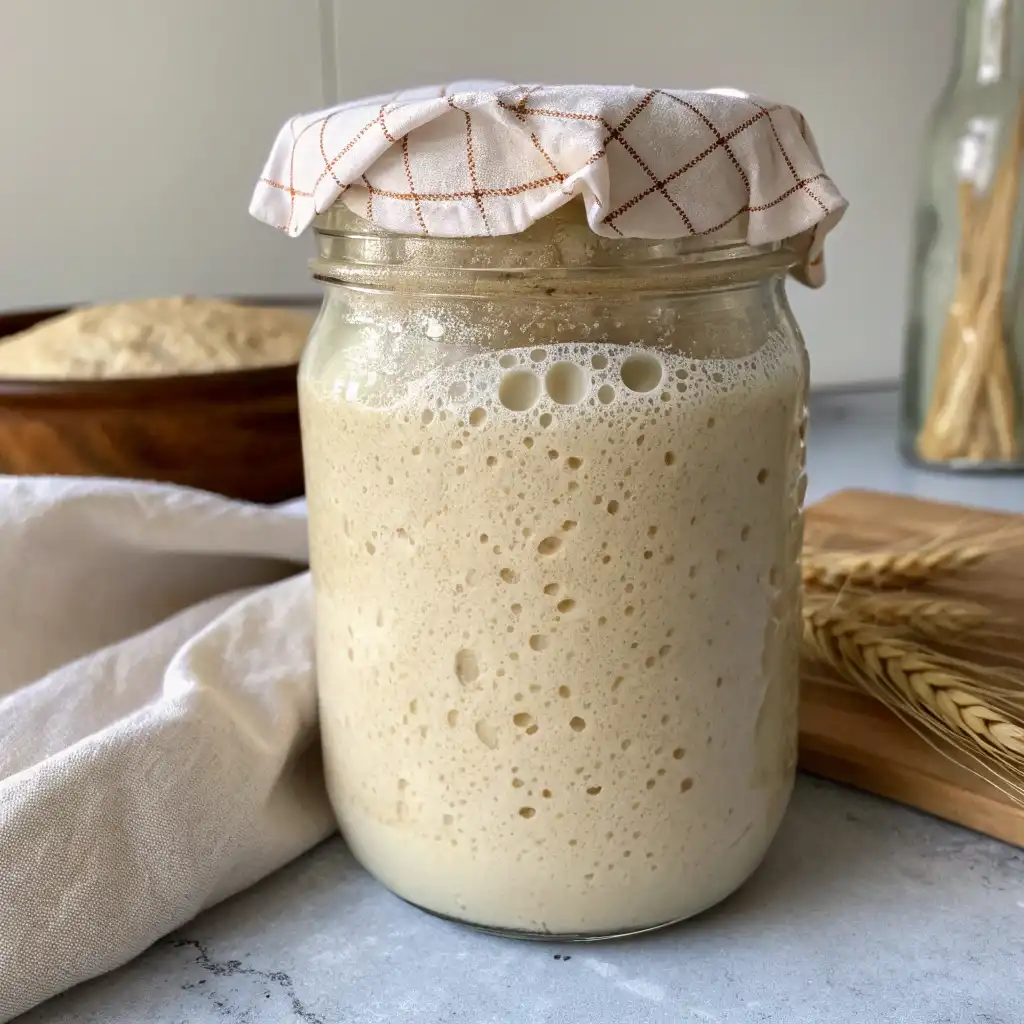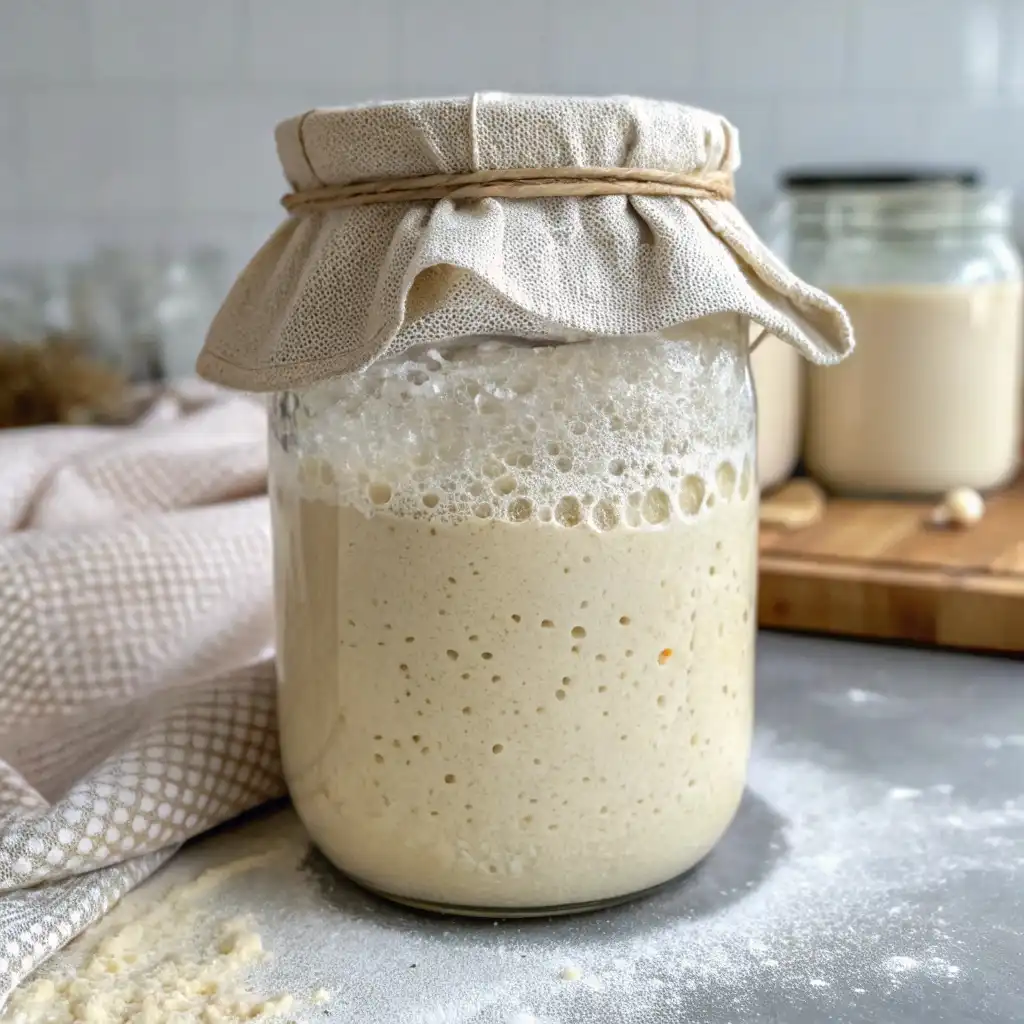How to store sourdough starter in the fridge is the best option if you bake once or twice a week. When kept at a cool temperature, your starter slows down its activity, so you don’t need to feed it daily. Instead, you can follow a regular schedule, refreshing it about once a week. Before refrigerating, feed your starter and let it rise slightly at room temperature. Then, seal it loosely in a jar and place it in the fridge. If you’re unsure how to refresh it, check out our detailed guide on How to Feed a Sourdough Starter: Step-by-Step Feeding Guide.

Table of Contents
Table of Contents

How to Store Sourdough Starter Long Term
Instructions
- 1- Refrigeration MethodFeed your sourdough starter as usual.Place it in a clean glass jar with a loose lid.Store in the refrigerator for up to 2 weeks. Refresh before baking.
- 2. Freezing MethodFeed your starter, let it become bubbly.Place portions in freezer-safe containers.Freeze for up to 6 months. Thaw and feed twice before baking.
- 3. Drying MethodSpread a thin layer of fed starter onto parchment paper.Allow it to air-dry fully (24–48 hours).Break into flakes and store in an airtight jar for up to 1 year.
Freezing for Long-Term Storage
How to store sourdough starter for several months without maintenance is easiest through freezing. To do this, feed your starter and let it become active, then spread a thin layer on parchment paper or place spoonfuls in a freezer-safe container. Once frozen, your starter will remain dormant but viable for future use. When you’re ready to revive it, thaw at room temperature and begin feeding again with fresh flour and water. Choosing the right flour is key to bringing it back to life, and you can learn more in our guide on Best Flour for Sourdough Starter: A Complete Beginner’s Guide.
Drying Your Starter for Long-Term Storage
How to store sourdough starter in its most reliable form is through drying. This method is perfect if you don’t plan to bake for months but still want a backup that never fails.
To dry, spread a thin layer of fully fed starter onto parchment paper and let it air-dry until it becomes brittle. Break it into flakes and keep them in an airtight jar. When you need to bake again, simply rehydrate the flakes with equal parts water and flour. This technique is not only the safest way for long-term preservation, but it also ensures your sourdough culture never dies. If you’re curious about creating your starter from zero before drying it, check our step-by-step guide on How to make Sourdough Starter from Scratch: A No-Fail, Day-by-Day Recipe.
Refrigerating for Short-Term Storage
How to store sourdough starter in the fridge is the easiest method if you plan to pause baking for a few weeks. Once your starter is active and bubbly, feed it, let it rise for a couple of hours at room temperature, then move it to the refrigerator in a clean jar. This slows down fermentation and allows you to feed it just once a week. When you’re ready to bake, take it out, throw away half of it, and mix in the same amount of flour and water. If you’re not sure how to feed correctly, follow our detailed guide on How to Feed a Sourdough Starter: Step-by-Step Feeding Guide for consistent results.
Choosing the Right Method for You
How to store sourdough starter can vary depending on your baking routine. Here’s a simple table to help you decide which method works best for you:
| Method | Best For | Pros | Cons |
|---|---|---|---|
| Refrigeration | Bakers who bake weekly | Easy to maintain, feed only once a week | Requires planning ahead to reactivate starter before baking |
| Freezing | Occasional bakers (monthly use) | Long-term storage with minimal effort | Takes time to revive; not always as strong as fresh starter |
| Drying (Flakes) | Long-term or backup storage | Can last for years, easy to transport or share | Needs more steps to rehydrate before baking |
👉 If you’re unsure how to maintain the starter between uses, check this guide: How to Feed a Sourdough Starter: Step-by-Step Feeding Guide.
FAQ’s About How to Store Sourdough Starter
How to store sourdough starter if I bake every week?
If you bake weekly, the best method is refrigeration. Keep your starter in the fridge and feed it once a week. For details on proper feeding schedules, read How to Feed a Sourdough Starter: Step-by-Step Feeding Guide.
How to store sourdough starter long term without baking often?
For long-term storage, freezing or drying your starter into flakes works best. Dried starters can last for years and are easy to revive. If you want to learn how to create your first starter, check How to Make Sourdough Starter from Scratch: A No-Fail, Day-by-Day Recipe
What is the best flour for storing a sourdough starter?
Whole wheat and rye flour add strength when reviving a stored starter. To understand which flour works best, see Best Flour for Sourdough Starter: A Complete Beginner’s Guide
Can a sourdough starter survive months in the fridge?
Yes, but it will need several feedings to become strong again. If you encounter problems reactivating, visit Sourdough Starter: The Complete Guide to Making, Feeding, and Fixing It for troubleshooting tips.
Should I feed my sourdough starter before freezing or drying?
Yes. Always feed it first, let it become active, then freeze or dry. This ensures the yeast and bacteria remain healthy during storage.
Conclusion ” how to store Sourdough starter “
Learning how to store sourdough starter properly ensures you always have a healthy culture ready to bake with, whether you store it in the fridge, freezer, or as dried flakes. The right method depends on how often you bake and the level of care you want to provide. If you bake often, refrigeration works best, but for long-term solutions, drying or freezing is more reliable.
To make the most of your sourdough journey, be sure to explore our detailed guides:
How to Feed a Sourdough Starter: Step-by-Step Feeding Guide
Best Flour for Sourdough Starter: A Complete Beginner’s Guide
How to Make Sourdough Starter from Scratch: A No-Fail, Day-by-Day Recipe
How to Revive a Sourdough Starter: Step-by-Step Guide
And for a full deep dive into care, troubleshooting, and baking success, don’t miss our ultimate resource: Sourdough Starter: The Complete Guide to Making, Feeding, and Fixing It.
With these tips, your sourdough starter can last a lifetime, giving you endless delicious loaves.
for more recipes about this subject you can visit our page Pinterest or Facebook

